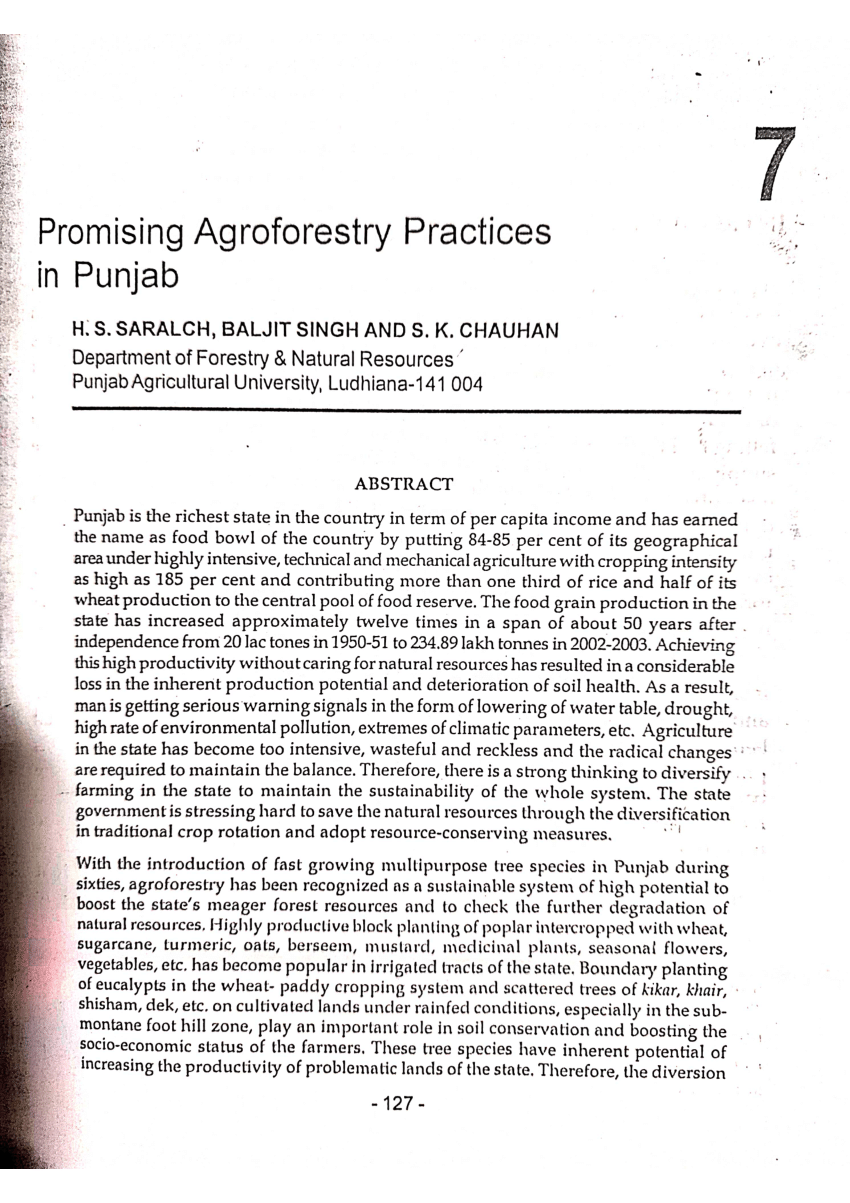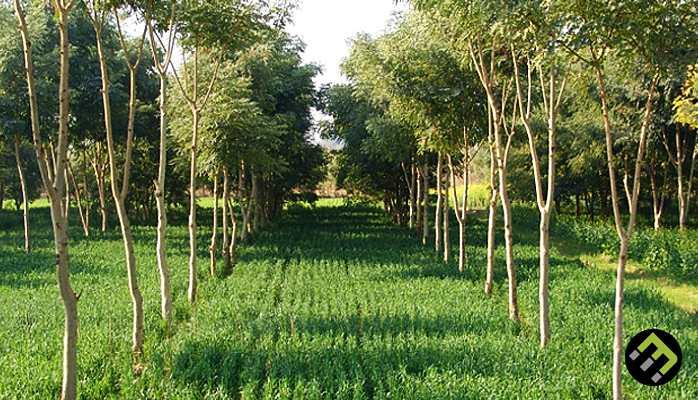Selecting Suitable Tree Species for Punjab Agroforestry

Agroforestry is a land management practice that integrates trees and shrubs with crops and/or livestock. It offers numerous benefits, including increased crop yields, improved soil fertility, and additional income sources. Selecting the right tree species is crucial to the success of any agroforestry system.

Criteria for Tree Species Selection

- Compatibility with crops and livestock
- Economic value
- Growth rate and productivity
- Adaptation to local climate and soil conditions
- Disease resistance and tolerance to pests
- Tolerance of waterlogging and salinity
- Fodder and shelter value for livestock
- Fuelwood and timber potential
Suitable Tree Species for Punjab Agroforestry
Based on the above criteria, the following tree species are recommended for agroforestry in Punjab:
- Acacia nilotica (Babul): Nitrogen-fixing, drought-tolerant, provides fuelwood, timber, and fodder.
- Azadirachta indica (Neem): Medicinal properties, repels pests, provides shade and fodder.
- Dalbergia sissoo (Shisham): Valuable timber, provides shade and fodder.
- Eucalyptus spp.: Fast-growing, high wood yield, suitable for pulpwood and fuelwood.
- Leucaena leucocephala (Ipil-ipil): Nitrogen-fixing, provides fodder and green manure.
- Melia azedarach (Chinaberry): Timber value, provides shade, and repels pests.
- Morus alba (Mulberry): Fruit-bearing, provides fodder, and supports sericulture.
- Prosopis cineraria (Khejri): Drought-tolerant, provides fodder, fuelwood, and pods for human consumption.
- Salix alba (White willow): Suitable for saline and waterlogged areas, provides fuelwood and fodder.
- Ziziphus mauritiana (Ber): Fruit-bearing, provides shade and fodder.
Conclusion
Selecting the right tree species is essential for establishing a successful agroforestry system in Punjab. The recommended species offer a range of benefits, including economic value, environmental protection, and fodder provision. By considering the specific needs of the agroforestry system and the local climate and soil conditions, farmers can maximize the potential of agroforestry practices in Punjab.## Selecting Suitable Tree Species for Punjab Agroforestry
Executive Summary
Agroforestry has been widely adopted in Punjab as a sustainable land management practice, enhancing agricultural productivity, environmental protection, and socio-economic development. The selection of appropriate tree species is crucial for ensuring the success and sustainability of agroforestry systems in the region. This article provides a comprehensive guide to selecting suitable tree species for Punjab agroforestry, considering the specific ecological and socio-economic conditions of the area and highlighting the most promising species for different purposes.
Introduction
Punjab, a prominent agricultural region in India, recognizes agroforestry as an integral part of its sustainable farming strategy. Trees provide multiple benefits in agroforestry systems, including soil health improvement, crop yield enhancement, livestock fodder, and income generation. However, the success of agroforestry depends heavily on the selection of suitable tree species that align with local conditions, address farmers’ needs, and contribute to overall sustainability goals.
FAQs
- What factors should be considered when selecting tree species for agroforestry?
- Ecological suitability (climate, soil type, water availability)
- Purpose of the agroforestry system (e.g., timber, fuelwood, fodder)
- Agronomic characteristics (growth rate, disease resistance, compatibility)
- Socio-economic considerations (market demand, farmer preferences)
- How can I identify the most suitable tree species for my agroforestry system?
- Consult with local experts (e.g., agricultural extension officers, forestry departments)
- conduct site-specific assessments (e.g., soil testing, climate analysis)
- explore agroforestry research and best practices for your region
- Are there any resources available to assist me in selecting tree species for agroforestry?
- Government agencies (e.g., Punjab Agricultural University, State Forest Departments)
- Non-profit organizations (e.g., World Agroforestry Centre, International Centre for Research in Agroforestry)
- Online databases and decision support tools (e.g., Agroforestry Species Finder, Tree Selector Tool)
Subtopics
Ecological Suitability
Ecological suitability refers to the tree species’ adaptability to the specific environmental conditions of the agroforestry system. It includes factors such as climate, soil type, water availability, and local ecology.
- Climate: Consider the average temperature, rainfall, humidity, and frost tolerance of the tree species.
- Soil type: Pay attention to soil pH, texture, fertility, and drainage characteristics.
- Water availability: Determine the drought tolerance or water requirements of the tree species.
- Local ecology: Consider the presence of native plant species, competing species, and potential pests or diseases.
Purpose of the Agroforestry System
The purpose of the agroforestry system guides the selection of tree species based on their intended use. Different species may be suitable for timber production, fuelwood, fodder, soil conservation, or other purposes.
- Timber production: Focus on species with high growth rates, good wood quality, and resistance to pests and diseases.
- Fuelwood: Select species with high biomass production, fast growth, and coppicing ability.
- Fodder: Choose species with high nutritive value, palatability, and drought tolerance.
- Soil conservation: Opt for species with extensive root systems that help prevent erosion and improve soil fertility.
Agronomic Characteristics
Agronomic characteristics relate to the growth, performance, and compatibility of the tree species within the agroforestry system. They include factors such as growth rate, disease resistance, drought tolerance, and compatibility with other crops.
- Growth rate: Consider the desired rate of growth and whether the tree species will reach maturity within the project timeframe.
- Disease resistance: Choose species with known resistance or tolerance to common pests and diseases in the region.
- Drought tolerance: Select species that can withstand periods of water scarcity without significant yield reduction.
- Compatibility: Ensure compatibility with other crops or vegetation in the agroforestry system, considering factors such as allelopathy and competition for resources.
Socio-Economic Considerations
Socio-economic considerations address the market demand, farmer preferences, and the availability of technical and financial resources. They influence the selection of species that are economically viable and socially acceptable.
- Market demand: Identify tree species with established markets for their products (e.g., timber, fuelwood, fodder).
- Farmer preferences: Consider farmers’ knowledge, skills, and preferences regarding tree species selection and management.
- Technical and financial resources: Evaluate the availability of technical support, extension services, and financial assistance for the selected species.
Promising Tree Species for Punjab Agroforestry
Based on the above considerations, the following tree species have been identified as promising candidates for agroforestry in Punjab:
- Azadirachta indica (Neem): Timber, medicinal properties, allelopathic effects
- Acacia nilotica (Babul): Fuelwood, fodder, soil conservation
- Dalbergia sissoo (Shisham): Timber, fodder, medicinal properties
- Eucalyptus camaldulensis (Red Gum Eucalypt): Timber, fuelwood, fast growth
- Leucaena leucocephala (Subabul): Fodder, soil improvement, fast growth
Conclusion
The selection of suitable tree species is essential for the success and sustainability of agroforestry systems in Punjab. By considering the ecological, agronomic, socio-economic, and purpose-specific criteria outlined in this article, farmers and stakeholders can make informed decisions that maximize the benefits of agroforestry. The implementation of appropriate tree species will enhance agricultural productivity, environmental protection, and the overall well-being of rural communities in Punjab.
Keywords
- Agroforestry
- Tree species selection
- Punjab
- Ecological suitability
- Socio-economic considerations